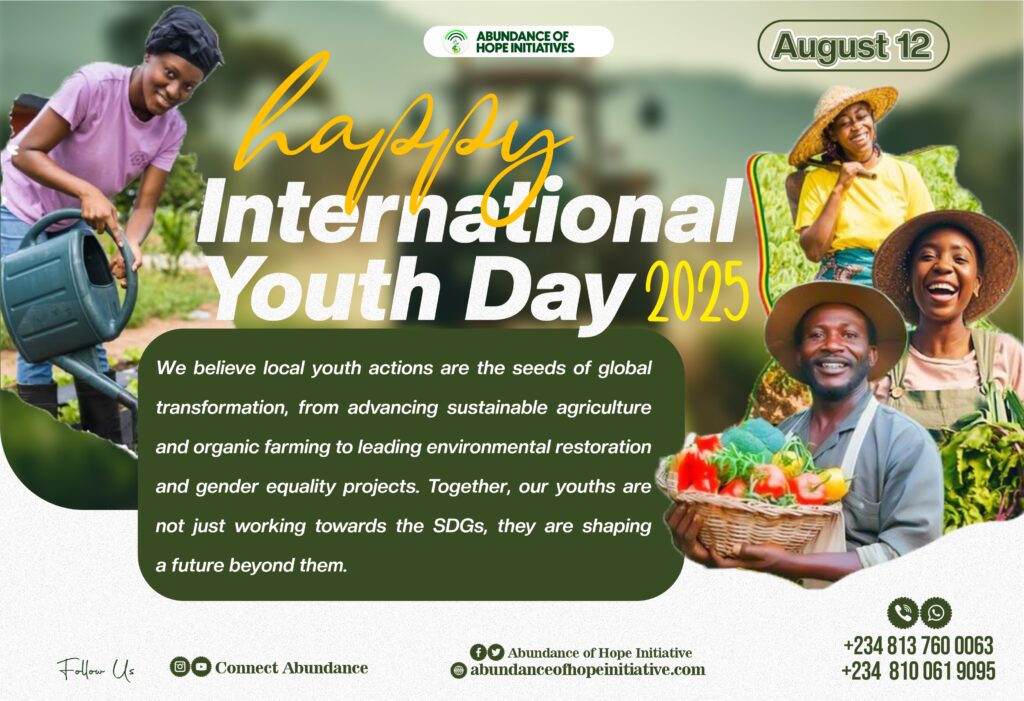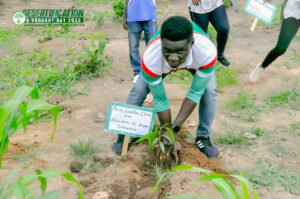Local Youth Actions for the SDGs and Beyond: How Young People Are Powering a Sustainable Future.
On August 12th, 2025, the world once again turned its spotlight on young people as we mark International Youth Day. This year’s theme, “Local Youth Actions for the SDGs and Beyond”, could not be more timely.
In an era marked by climate change, food insecurity, gender inequality, and economic uncertainty, youth are proving that the most powerful solutions often start at the grassroots. Their creativity, resilience, and passion are breathing life into the Sustainable Development Goals (SDGs) and pushing us to imagine what lies beyond 2030.
At Abundance of Hope Initiative, we see this every day. From young farmers embracing organic methods, to women-led cooperatives producing sustainable honey, to climate-conscious youth planting trees in their communities, we’ve witnessed firsthand how local action fuels global change.
Understanding the SDGs & the Role of Youth
The 17 Sustainable Development Goals, adopted by the United Nations in 2015, provide a blueprint for a better, more sustainable world. They span everything from ending poverty (SDG 1) and achieving zero hunger (SDG 2) to promoting gender equality (SDG 5), taking climate action (SDG 13), and ensuring quality education (SDG 4). Youth are not just the beneficiaries of these goals, they are critical drivers. With over 1.2 billion people aged 15-24 globally, young people represent the largest generation in history. Their unique perspective, tech-savvy skills, and community-rooted leadership make them indispensable in achieving, and even surpassing the SDGs.
But what makes local youth action so important? Because the SDGs are only as effective as their implementation in communities. When young people act locally, in farms, schools, marketplaces, and neighborhoods, they tailor solutions to real needs and create change that lasts.
Local Youth Actions Driving Change: Real Stories of Impact
1. Youth in Organic Farming & Food Security (SDG 2: Zero Hunger)
In many parts of Nigeria, youth-led farms are turning to organic farming to combat soil degradation, reduce chemical dependency, and produce healthier food. Through Abundance of Hope Initiative’s training programs on organic farming practices, young farmers are learning climate-smart techniques such as composting, crop rotation, and natural pest control.
These methods not only improve yields but also protect the environment, ensuring that the next generation can still farm the land. In Kabba/Bunu, for example, a group of trained youth now supplies organic vegetables to local schools, improving both incomes and children’s nutrition.
2. Bee Keeping for Livelihoods & Pollination (SDG 8: Decent Work and Economic Growth, SDG 15: Life on Land)
Bees are tiny but mighty allies in the fight for sustainability. They pollinate crops, enhance biodiversity, and produce honey, a valuable source of income. Abundance of Hope Initiative has empowered youth with skills in bee keeping, honey production, and beeswax processing, creating pathways to financial independence. Young beekeepers like Aisha, a 23-year-old graduate, now manage multiple hives, sell organic honey at premium prices, and train other young women proving that sustainable agriculture can be both profitable and community-driven.
3. Tree Planting & Climate Change Mitigation (SDG 13: Climate Action)
Tree planting is one of the most visible local actions for climate resilience. Youth volunteers have led community reforestation drives, restoring degraded land and creating microclimates that support agriculture. This aligns perfectly with the 2025 Desertification and Drought Day theme: “Restore the Land, Unlock Opportunities” and demonstrates how youth-led environmental stewardship supports both livelihoods and ecosystems.
4. Women & Youth Empowerment in Agribusiness (SDG 5: Gender Equality)
Agriculture has historically been male-dominated, but youth-led advocacy and training are changing that. Abundance of Hope Initiative’s organic poultry management and feed production training has opened doors for young women to become agripreneurs.
This isn’t just about fairness, it’s about economics. Studies show that closing the gender gap in agriculture could reduce hunger for up to 150 million people. When women have equal access to land, training, and markets, communities thrive.
Challenges Youth Face and How to Overcome Them.
Even with the passion and vision, young change-makers often face these obstacles:
-
Limited access to funding and land
-
Lack of technical resources
-
Market barriers for selling organic or sustainable products
-
Climate-related risks such as droughts and flooding
Abundance of Hope Initiative addresses these obstacles by:
-
Offering low-cost training and starter kits for agriculture projects
-
Connecting youth to microfinance opportunities
-
Building market linkages for sustainably produced goods
-
Hosting climate adaptation workshops for rural communities
Beyond the SDGs: Building a Future of Abundance
The SDGs have given us a common vision, but the work doesn’t end in 2030. Youth actions must evolve to tackle emerging challenges, from AI in agriculture to new environmental threats.
Abundance of Hope Initiative is already looking ahead, expanding into digital agriculture training, climate-smart irrigation systems, and sustainable value-chain development. The goal? Not just to meet targets but to build thriving communities where opportunity is abundant, and hope is real.
Whether you are a policymaker, a private sector leader, or simply someone who believes in a sustainable future, you have a role to play by Supporting youth-led projects through funding or mentorship, Adopt sustainable practices in your own life and community and Amplify youth voices in decision-making spaces.



